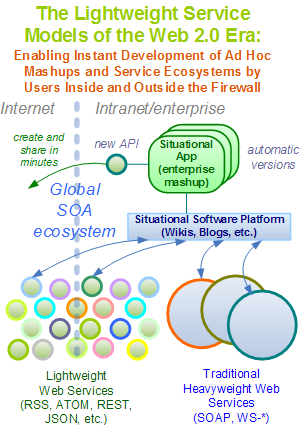Web 2.0 Summit: IBM evolves vision of SOA and Web 2.0

One of the most consistent trends on the Internet is the rise of open APIs and the applications built on top of them, known as mashups. Programmable Web currently lists over 300 APIs that can be used for everything from building Web sites on top of Google Maps to using Amazon's powerful infrastructure APIs for storage and cluster computing. The underlying trend: The desire to easily remix the vast pool of high value data and services on the Web today into useful new solutions, at home and perhaps even in the enterprise.
In a late morning session today at the Web 2.0 Summit, IBM's Rod Smith painted a compelling picture of this mashup trend combined with the emerging edge of enterprise IT. The result? A surprisingly close relationship between the somewhat stodgy world of service-oriented architecture (SOA) and the bustling world of consumer Web 2.0.
The convergence of SOA and Web 2.0, two highly interrelated trends that are very focused on 1) connecting people and systems together easily, 2) making software and data available for reuse via services, and 3) building new value upon the foundation of existing information resources and IT assets. This convergence is something I've been following quite closely for a while, particularly in some key exploratory blogs and articles late last year.

SOA/Web 2.0 convergence is important topic since many of the biggest challenges in enterprise IT are actually being solved today out on the Web, particular around the best way to engage users, deliver highly usable software, integrate systems, and achieve high levels of reuse and adoption. So it was fascinating to hear the experiences of Rod and his team over the last year, where they've visited over a 100 customers sites and taken the temperature of CIOs in terms of how Web 2.0 can help them with their business problems.
The story is a fascinating one and in this first part of two, we'll take a look at what Rod and his team at IBM is uncovering in the business trenches in terms of Web 2.0's applicability, penetration, and value proposition to the enterprise.
Rod started out the session talking about Web 2.0's usefulness not so much as a technology, but primarily as adding value to the business. He identified three key Web 2.0 trends that are important to business:
- Services, not software. Citing the patterns out on the Web of online software providing a much tighter connection between the product and customers, Rod noted that successful services on the Web focused on user-driven adoption, business value on demand, low cost to entry, leveraging of public infrastructure, and probably most important, tight feedback loops between providers and consumers. Shortening and automating key feedback loops are a hallmark of what's happening out on the Web.
- Community. Creating a user base where users add value, providing social networking features, allowing user organization of data with things like tagging, allowing simple feedback mechanisms like user comments and ratings, and things like community rights management (such as eBay reputation system), provides for important ways to capture essential value that useful to other customers and businesses alike. The key here said Rod is that communities facilitate "getting in touch with a community of people that are your customers or constituents" and the organizations that "get best in touch with their users via contributions, ratings, feedback will be the online businesses that are most successful." And I couldn't agree more.
- Simple. As I said recently in my habits of highly effective Web 2.0 sites, ease-of-use is the single most important aspect of any Web site or program. And that certainly includes APIs as well as actual end-user experiences. Rod observed that is should be easy to remix as well, with feeds being a key aspect of simple. Feed formats like RSS and Atom allows low-barrier remixing that "builds up an ecosystem that is more vibrant, open, and decentralized."
A key drivers for Web 2.0 in the enterprise however is the desire to "connect the large population of employees together, to quickly and easily find qualified people that can deal with problems that come up in the enterprise." The use of open, shared collaborative tools with discovery mechanisms that are almost entirely self-service opens up compelling possibilities in knowledge retention and information sharing (in other words, identifying internal experts based on previous Web 2.0-style peer contributions).
Interestingly, Rod picked up on a key element of enterprise business activity that many, including myself, believe to be the last major bastion of worker productivity gains: tacit interactions, which he calls "informal work patterns", saying that the vast majority of work in the enterprise is ad hoc and "not filling out an SAP form."
After this point, Rod had a CTO from American Express talk about their experiences applying Web 2.0 in a large financial company and then had David Barnes come up and demo the QEDWiki platform to articulate the vision of situational mashup applications, connected bidirectionally via feeds. Dashboards and situational apps can be built in minutes instead of hours, wired together, and even be connected to Internet-based and enterprise IT resources in two directions. David actually showed all of this working and built an entire application with phone book integration, financial data integration and charts and graphs, all then re-exposed via an API, forming yet another new service that can be shared out to the enterprise or the "Global SOA" on the Internet.
One very compelling aspect of using the wiki (editable Web page) as the platform for end-user situational software development is that it already supports many important features such as automatic versioning and security, ensuring that all apps changes are backed up and retrievable as well as secured from basic unauthorized use.
Rod wrapped up by touching on the concept of "disposable solutions", built to use once in an emergent, adaptive fashion and thrown away when the finished, a far cry he noted from the current practice of trying to build it right the first time, every single time. This gives rise to the following revision to the Web development model:
The Next Rev of the Web Programming Model (Source: IBM)
- Rich Internet Applications (Ajax, Flash, etc.)
- Instant Web apps (minutes instead of hours and days)
- Lightweight programming models
- Mashable assets (new -- and just as importantly, existing IT resources (Ross Mayfield) made to work in this new situational model)
- Feeds
Now, for those not sure this is all really happening, the fascinating part are the demos I'm seeing here at the conference. Situational software is clearly on the cusp of becoming a reality and for those skeptical readers in the audience, this stuff is real and it's clearly compelling. I'm looking to do a screencast of the some of the more impressive apps I'm seeing here or have been shown in the last few weeks. As Rod pointed out, live users are still the manual integration point of our systems far too often, and now it's getting easier and easier for the average person to direct software do the integration automatically.
Update: David Barnes sent me this YouTube hosted screencast of QEDWiki in action that lets you see roughly what we saw yesterday and demonstrates the potential of using wikis as an end-user platform for creating enterprise mashups and leveraging "mashable assets". Definitely worth a look.
Note: The second part of this story is coming up next and will be the story of Bob Morgan, VP of the Chief Technology Office of American Express, who used some time at Rod's session to talk about various real-world uses of Web 2.0 techniques at the world-famous financial services company. A great story about what's actually happening with Web 2.0 in the enterprise.